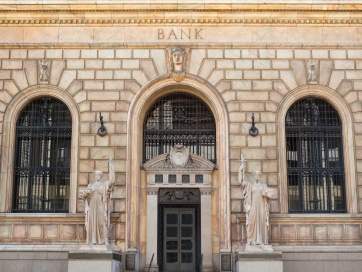
An analysis of bank governance reveals a new roadmap for regulatory reform.
In the lead up to the banking crisis of 2007–2008, U.S. banks engaged in systemic, excessive risk-taking that drove the economy to the verge of collapse. How this was possible is still puzzling. What can explain systematic, excessive risk-taking by all of the U.S. banks?
One popular answer points to the failure of bank governance. On this view, rapacious bank CEOs usurped the internal governance arrangements that should have protected bank investors from excessive risk-taking. This usurpation produced a system of skewed incentive schemes, complacent risk managers, and captured boards that allowed a pervasive culture of risk-taking to flourish.
This narrative, however, fails to take into account the causal relationship between external and internal governance. Internal governance arrangements do not operate in a vacuum. Instead, they are the function of external governance, that is, the oversight and influence that both shareholders and debtholders exercise over the corporation.
Under this different conceptual framework, the crisis emerges as the result of a moral hazard problem involving bank shareholders and debtholders, rather than bank managers. The source of this problem lies in the existence of safety nets—deposit insurance and bailouts—which distort bank investors’ risk preferences, depriving them of the incentives to seek governance arrangements that constrain excessive risk-taking.
A counterfactual analysis of banks’ likely internal governance arrangements in the absence of safety nets is useful to illustrate this argument. The corporate finance canon teaches that debtholders charge higher interest rates in response to the shareholders’ preferences for high-risk, high-return projects. These preferences arise because, under the limited liability of the corporate form, shareholders expect to reap the full upside from riskier projects, while debtholders bear most of the downside risk. Anticipating these circumstances, debtholders demand higher interest rates, which reduce expected equity returns.
In response, shareholders have incentives to appease debtholders by committing their firms to sound risk choices, especially in highly-leveraged corporations. Indeed, higher leverage increases shareholders’ expected returns from riskier projects while simultaneously increasing debtholders’ exposure to losses. Hence, shareholders of highly-leveraged firms need a stronger commitment to sound risk policies than a majority of their corporate counterparts. This stronger commitment comes in the form of safe governance arrangements. Observation from the practice of highly-leveraged firms suggests that the distinguishing feature of such arrangements is the incorporation of the debtholders’ risk preferences into the corporate decision-making process, typically through the appointment of a debtholder representative to the board.
This appointee serves as a counterweight to the CEO, who, in response to the common use of equity-based executive compensation, shares the same preferences of risk-liking shareholders. The result of this organizational model based on antagonistic information gathering and contrarian thinking—what economists call an advocacy model—is that the board’s decisional outcomes are less likely to be biased toward increased risk-taking.
Banks are the classic example of highly-leveraged corporations. Thus, the theoretical analysis of the interplay between external and internal governance suggests that debt discipline would prompt bank shareholders to seek safe governance arrangements, such as an advocacy model.
In the real world, however, with the introduction of governmental insurance, safe bank governance is lost. Under the protection of safety nets, bank debtholders become almost insensitive to risk-taking and opportunistically avoid monitoring banks. This debtholder opportunism, in turn, leads to a theory of rational passivity of bank shareholders. Without the constraint of debt discipline, bank shareholders, have no incentives to police governance arrangements that induce excessive risk-taking. Instead, they find themselves benefiting from such arrangements.
This account of bank governance dynamics not only replaces the view that managerial opportunism has been the central cause of excessive bank risk-taking, but it also suggests a new direction for regulatory reform.
Presently, regulators focus on capital requirements to constrain excessive risk-taking in the banking sector in the belief that higher equity levels can make riskier projects unprofitable for both shareholders and equity-compensated managers. But, this is a crude and socially expensive solution which fails to give bank shareholders incentives to move away from CEO-centric, and risk-prone, governance models.
A better approach to preserve bank stability would restore effective disciplining incentives for bank shareholders, encouraging the adoption of safe governance arrangements. To this end, bank regulators should assume the hypothetical position of uninsured bank debtholders, disciplining bank shareholders as debtholders would in a world without safety nets. Under this contractarian approach, where debtholders would offer lower interest rates in exchange for safer governance, regulators would offer lower regulatory costs while demanding the same governance concessions.
The practice of highly-leveraged corporations outside the banking sector suggests that incentivizing the adoption of advocacy models could fulfill this objective. Banks could replicate a similar decision-making structure through two basic organizational features. The first is the appointment of a “representative” of the debtholders’ interests within the bank, for example an insider whose payoff structure is selected to align her risk preferences with the debtholders’ preferences. In accordance with recent international banking guidelines that stress the importance of risk management as a primary internal control mechanism, the chief risk officer (CRO) emerges as a natural candidate for the role. The second component of an advocacy model in banks is the creation of a fully independent board of directors. This feature would be necessary to preserve the board’s ability to act as an impartial decision maker in reviewing the competing cases for risk advanced by the CEO and the CRO.
A regulatory option to promote the adoption of similar governance models would be making banks’ regulatory costs—capital requirements and deposit insurance premiums—sensitive to banks’ organizational features. In practice, regulators should allow banks to trade advocacy-based governance features for lower regulatory costs. For example, banks opting for an advocacy model could be held to the lower capital ratio currently required for adequately capitalized banks. In contrast, banks that maintain a CEO-centric governance model could be held to the higher capital ratio that is required for a bank to be well capitalized.
The major challenge associated with this suggested approach to bank regulation reform would arise in the refinement of proper regulation strategies. But, a discussion of the potential for advocacy in banks is a necessary first step toward redirecting bank shareholders’ incentives toward more socially responsible risk-taking.




